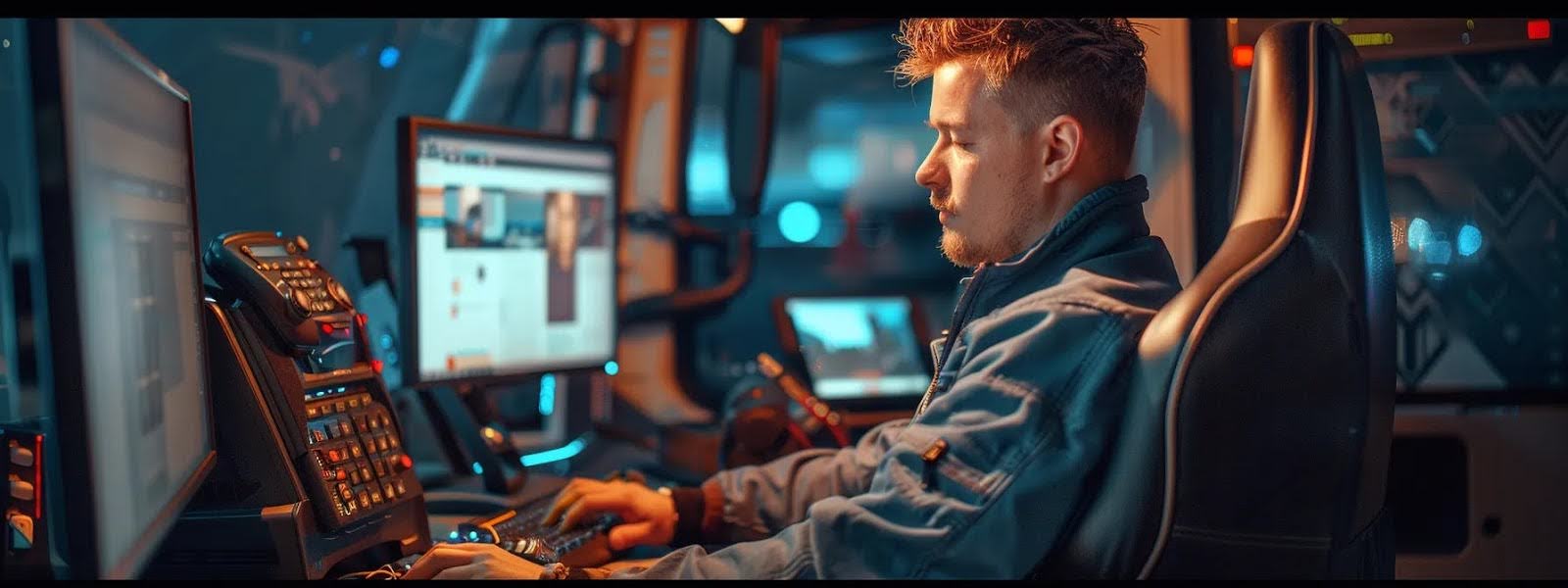Apr 13
CDL License Training for Beginners: Your Roadmap to a Commercial Driving Career
CDL License Training for Beginners: Your Roadmap to a Commercial Driving Career
Starting a new career as a commercial driver might feel overwhelming at first, especially if you’ve never been behind the wheel of a big rig or bus. But don’t worry you’re not alone. Every professional driver started out where you are right now: looking for clear, step-by-step CDL license training that makes sense for beginners.
Whether you’re thinking about driving locally, across state lines, or transporting passengers, getting your Commercial Driver’s License (CDL) is the first move. And the good news? You don’t need any prior experience. With the right training especially one that’s beginner-friendly and flexible—you can earn your CDL and start working in just a few weeks.
At OnlineTrafficSafety.com, we specialize in helping first-time drivers prepare for their CDL exam with fully online, FMCSA-approved training. In this guide, we’ll walk you through what CDL training is, how it works, and how to get started today.
What Is a CDL and Why Does It Matter?

A Commercial Driver’s License (CDL) is a federally regulated credential that allows you to operate large or specialized vehicles for commercial purposes. If you want to drive a truck, bus, tanker, or other heavy vehicle, a CDL isn’t optional—it’s required by law.
There are three main CDL classes:
- Class A CDL: For operating combination vehicles like semi-trailers and tractor-trailers (e.g., 18-wheelers). This is the most versatile license and opens up opportunities in long-haul and regional freight.
- Class B CDL: For operating straight vehicles like delivery trucks, school buses, garbage trucks, and cement mixers. This license is ideal for local driving jobs.
- Class C CDL: For smaller vehicles that transport hazardous materials or 16+ passengers. Think shuttle buses or hazmat vans.
Understanding the difference between CDL classes helps you choose the right training path based on your career goals.
Who Should Consider CDL Training?
CDL training is perfect for:
- Career changers looking for stable, high-paying work
- Young adults entering the workforce
- Veterans transitioning to civilian jobs
- Gig workers and delivery drivers ready to level up
- Anyone interested in travel or logistics
Whether you want to stay local or explore the open road, commercial driving offers job security, independence, and consistent income. There’s a nationwide driver shortage right now which means more opportunities for new drivers than ever before.
What Does CDL Training Include?

CDL training is designed to help you pass both parts of your licensing process:
CDL Theory (Knowledge) Training
This is the classroom or online portion of your training. It covers all the federal and state rules you’ll need to pass the written knowledge test, including:
If you're just getting started, our CDL courses for beginners are built to walk you through all of this in simple, clear language.
- Vehicle safety and inspection procedures
- Traffic laws and FMCSA regulations
- Handling air brakes and combination vehicles
- Cargo security and weight distribution
- Hours of service and logbooks
- Defensive driving and hazard recognition
If you're just getting started, our CDL courses for beginners are built to walk you through all of this in simple, clear language.
Behind-the-Wheel (BTW) Training
This is the hands-on portion of your CDL training where you learn to drive and maneuver commercial vehicles under supervision. You'll practice:
- Pre-trip inspections
- Basic control skills (backing, turning, lane positioning)
- On-the-road driving
- Parking, braking, and handling real-world traffic
The theory portion can be completed online, but the driving portion must be done in person through a certified training center in your state.
ELDT: A New Requirement for All Beginners

As of February 7, 2022, all new CDL applicants must complete Entry-Level Driver Training (ELDT) before taking the skills test. This federal rule ensures that new drivers receive a consistent, safe, and compliant education.
Our online ELDT course is designed to meet every one of these needs—no classroom required.
So, what does that mean for you?
It means you must complete a training course from an FMCSA-registered provider, like OnlineTrafficSafety.com, before you can schedule your CDL skills test. Once you finish your ELDT course, your information is automatically submitted to the FMCSA Training Provider Registry, clearing you to move forward.
This requirement applies if you’re:
- Getting your first Class A or Class B CDL
- Upgrading from Class B to Class A
- Adding a passenger (P), school bus (S), or hazmat (H) endorsement
Our online ELDT course is designed to meet every one of these needs—no classroom required.
Why Start with Online CDL Training?
Online CDL training is a smart choice for beginners for several reasons:
Learn at Your Own Pace
No need to sit through hours of lectures or rearrange your work schedule. With our self-paced courses, you control when and how you learn.
Study from Anywhere
Access your course from home, your phone, a tablet, or anywhere with internet. Start and stop anytime—your progress saves automatically.
Save Money
Save Money
Traditional CDL schools can cost $4,000 to $8,000 just for the theory portion. Our online training is a fraction of the price, with no hidden fees.
Beginner-Friendly Format
We’ve designed our lessons with new drivers in mind. No technical jargon. No prior knowledge needed. Just straightforward, step-by-step instruction.
How Long Does CDL Training Take?
CDL training can move quickly, even for beginners. Here's a general timeline:
- Online theory training: As little as 1–2 days, or up to a few weeks if done part-time
- Behind-the-wheel training: Typically 3 to 6 weeks, depending on the program
- State exam scheduling: Varies, but many students are fully licensed within 4–8 weeks
The flexibility of online learning lets you move as fast—or as steady—as you want.
What You Need to Start CDL Training
Before you start your training, make sure you meet the basic requirements:
Once you’re ready, the first step is to get your Commercial Learner’s Permit (CLP). Our training helps you prep for that test too.
- Be at least 18 years old (21 for interstate driving)
- Hold a valid driver’s license
- Have a clean driving record (minor issues may be okay)
- Pass a DOT physical exam and drug screening
- Have proof of U.S. citizenship or lawful residency
Once you’re ready, the first step is to get your Commercial Learner’s Permit (CLP). Our training helps you prep for that test too.
How Much Does CDL Training Cost?

Costs vary, but here’s what to expect:
- In-person schools: $4,000–$8,000 depending on location
- Online CDL theory courses: Usually $75–$300
At OnlineTrafficSafety.com, our beginner CDL courses are affordable and include:
- ELDT-compliant training
- Instant certification submission to the FMCSA
- Lifetime access to course material
- No extra fees, ever
You only pay once and can start learning right away.
Tips for Beginners in CDL Training
CDL training is doable—even if you’ve never touched a big truck. Here are a few tips to help you succeed:
- Be consistent: Study a little every day, rather than cramming at the last minute.
- Use the practice tests: They help reinforce your learning and build test-day confidence.
- Take notes: Writing down key points will help you retain information better.
- Don’t be afraid to ask questions: Our team is here to help.
- Rest before your test: A clear mind goes a long way on exam day.
Why Beginners Choose OnlineTrafficSafety?
We’re more than just a training provider—we’re your partner on the road to certification. When you're starting from scratch, you need training that’s:
- Simple to follow
- Backed by federal approval
- Flexible enough for real life
- Proven to help you pass
Here’s what you get with our CDL training for beginners:
✅ FMCSA-registered and ELDT-compliant
✅ 100% online and self-paced
✅ Step-by-step guidance
✅ Instant certificate reporting
✅ Friendly, fast support when you need it
Thousands of new drivers have already taken their first steps with us. You can be next.
Frequently Asked Questions
Do I need experience to start CDL training?
No. CDL training is built for beginners. You’ll learn everything you need—from safety rules to driving techniques.
Can I really train online?
Yes. The classroom portion of your CDL training (theory) can be completed fully online. You’ll still need to complete in-person driving lessons, but your online course satisfies federal training rules.
What’s the difference between Class A and Class B for beginners?
Class A allows you to drive combination vehicles like tractor-trailers, while Class B is for single vehicles like buses and dump trucks. If you’re not sure, start with Class A—it gives you more job options.
How long does it take to get a CDL license from scratch?
Most beginners complete training and get licensed in about 4 to 8 weeks.
Is your training approved nationwide?
Yes. We’re an FMCSA-approved provider listed in the Training Provider Registry (TPR). Our certifications are valid in all 50 states.
Start Your CDL Training Today
Getting your CDL license is a smart, life-changing decision and it starts with quality training. Whether you want to drive locally, regionally, or coast-to-coast, it all begins with one simple step.
At OnlineTrafficSafety.com, we make CDL license training for beginners affordable, accessible, and easy to understand. Our online programs are trusted by first-time drivers across the country.
Who we are
Online Traffic Safety is at the forefront of delivering up-to-date and effective traffic safety training. We believe that informed drivers are safe drivers, and our goal is to equip every individual with the knowledge and skills needed to navigate the roads confidently and safely.
Featured links
Get in touch
-
info@onlinetrafficsafety.com
Connect with us
-
Facebook
-
Twitter
-
Youtube
-
Instagram
-
Linkedin
-
TikTok
Online Traffic Safety © 2025
